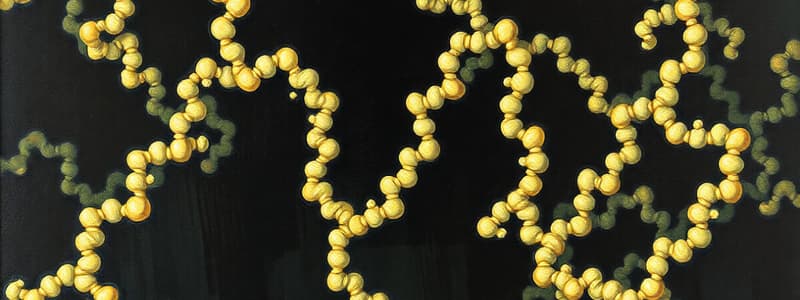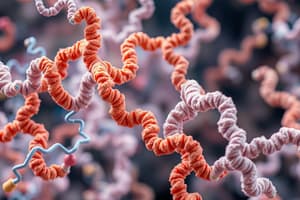Podcast
Questions and Answers
What role do proteins play in catalysis?
What role do proteins play in catalysis?
- They provide structural support.
- They increase the reaction rate of metabolic reactions. (correct)
- They transport substances across membranes.
- They store genetic information.
Which of the following is NOT a function of proteins?
Which of the following is NOT a function of proteins?
- Structural components in muscles.
- Storage of genetic information. (correct)
- Regulation of metabolic processes.
- Transport of oxygen in the blood.
Which component is NOT part of the common structure of amino acids?
Which component is NOT part of the common structure of amino acids?
- A phosphate group. (correct)
- An amino group.
- A central carbon atom.
- A carboxylic acid group.
What type of bonds are crucial in forming the structure of proteins?
What type of bonds are crucial in forming the structure of proteins?
Which structure of proteins refers to the unique sequence of amino acids?
Which structure of proteins refers to the unique sequence of amino acids?
Which of the following is NOT associated with protein denaturation?
Which of the following is NOT associated with protein denaturation?
How many amino acids can be found in nature?
How many amino acids can be found in nature?
How many standard amino acids are directly coded by DNA?
How many standard amino acids are directly coded by DNA?
Which amino acid is considered the 21st amino acid in eukaryotes?
Which amino acid is considered the 21st amino acid in eukaryotes?
Which of these is a function of proteins related to hormones?
Which of these is a function of proteins related to hormones?
What is the conformation of amino acids in protein structure?
What is the conformation of amino acids in protein structure?
Which of the following are classified as essential amino acids?
Which of the following are classified as essential amino acids?
At which point does the net charge of an amino acid equal zero?
At which point does the net charge of an amino acid equal zero?
What type of molecule are amino acids classified as?
What type of molecule are amino acids classified as?
Which of these correctly describes acidic amino acids?
Which of these correctly describes acidic amino acids?
What notation is often used to represent amino acids?
What notation is often used to represent amino acids?
What process occurs when a molecule of water is released during peptide bond formation?
What process occurs when a molecule of water is released during peptide bond formation?
Which structure is formed through local hydrogen bonds between amino acids?
Which structure is formed through local hydrogen bonds between amino acids?
What type of bond is formed between two cysteine residues in proteins?
What type of bond is formed between two cysteine residues in proteins?
How do hydrophobic amino acids behave in aqueous media?
How do hydrophobic amino acids behave in aqueous media?
What is the nature of biological activity after denaturation of a protein?
What is the nature of biological activity after denaturation of a protein?
Which of the following bonds contribute to the tertiary structure of proteins?
Which of the following bonds contribute to the tertiary structure of proteins?
What happens during renaturation?
What happens during renaturation?
Which term describes proteins made up of two or more polypeptide chains?
Which term describes proteins made up of two or more polypeptide chains?
Flashcards
Protein Functions
Protein Functions
Proteins perform various crucial roles in biological systems, including catalysis, transport, signaling, and structural support.
Amino Acid Structure
Amino Acid Structure
An amino acid is made up of a central carbon atom (α-carbon), a carboxyl group, an amino group, and a variable side chain (radical group).
Protein Catalysis
Protein Catalysis
Enzymes, a type of protein, accelerate chemical reactions within cells by lowering the activation energy required for these reactions.
Protein Transport
Protein Transport
Signup and view all the flashcards
Protein Signaling
Protein Signaling
Signup and view all the flashcards
Protein Structural Elements
Protein Structural Elements
Signup and view all the flashcards
Amino Acid
Amino Acid
Signup and view all the flashcards
Protein Structure
Protein Structure
Signup and view all the flashcards
Proteinogenic amino acids
Proteinogenic amino acids
Signup and view all the flashcards
Selenocysteine
Selenocysteine
Signup and view all the flashcards
L-conformation
L-conformation
Signup and view all the flashcards
Amino acid abbreviation
Amino acid abbreviation
Signup and view all the flashcards
Essential amino acids
Essential amino acids
Signup and view all the flashcards
Amphoteric molecules
Amphoteric molecules
Signup and view all the flashcards
Isoelectric point
Isoelectric point
Signup and view all the flashcards
Primary structure of a protein
Primary structure of a protein
Signup and view all the flashcards
Peptide Bond
Peptide Bond
Signup and view all the flashcards
α-helix
α-helix
Signup and view all the flashcards
β-sheet (β-pleated sheet)
β-sheet (β-pleated sheet)
Signup and view all the flashcards
Tertiary Structure
Tertiary Structure
Signup and view all the flashcards
Hydrophobic Interaction
Hydrophobic Interaction
Signup and view all the flashcards
Disulfide Bond
Disulfide Bond
Signup and view all the flashcards
Quaternary Structure
Quaternary Structure
Signup and view all the flashcards
Denaturation
Denaturation
Signup and view all the flashcards
Study Notes
Amino Acids and Protein Structure
- Proteins are biomacromolecules, constructed from amino acids, which carry out diverse functions.
- Learning objectives include listing protein functions, describing amino acid structure, calculating isoelectric points, identifying bonds forming proteins, recognizing protein structures (primary, secondary, tertiary, and quaternary), and explaining protein denaturation.
- Proteins are vital for numerous biological processes.
- Protein functions include catalysis (enzymes), transport, signalling, and structure.
Protein Functions
- Catalysis (enzymes): Enzymes increase reaction rates by lowering activation energy. For example, maltose is broken down to glucose in a fraction of a second, compared to taking 300 years without an enzyme.
- Transport: Proteins transport substances like oxygen (hemoglobin), lipids (lipoproteins), ions, water, and monosaccharides.
- Signalling: Hormones regulate metabolism, and receptors receive signals, initiating cellular responses.
- Structural elements: Cytoskeletons, muscles, hair, and nails are composed of proteins. Some proteins provide structure without direct function within the cell.
Protein Structure
- Proteins are built from amino acid sequences to form complex 3D structures.
- Ribosomes create protein structures via protein folding.
- There are four main protein structures: primary, secondary, tertiary, and quaternary.
Primary Structure
- The primary structure of a protein is its linear amino acid sequence.
- Amino acids are linked by peptide bonds.
- The order of amino acid sequences forms the polypeptide chain.
Secondary Structure
- Secondary structures are local configurations stabilized by hydrogen bonds between amino acid backbones. Common secondary structures are alpha-helices and beta-sheets.
- Secondary structures are frequently broken first during denaturation processes.
Tertiary Structure
- The tertiary structure is the overall 3D shape of a polypeptide chain. It's stabilized by various interactions (hydrogen bonds, disulfide bonds, ionic interactions, hydrophobic interactions, and van der Waals forces) between amino acid R groups.
- Hydrophobic amino acids are typically sequestered inside the protein, and hydrophilic amino acids tend to be on the exterior.
Quaternary Structure
- The quaternary structure describes the assembly of multiple polypeptide chains to form a functional protein.
- The subunits can be identical (homomultimers) or different (heteromultimers). These subunits typically make up the final, functional protein.
Amino Acids
- Amino acids contain an amino group (-NH2), a carboxyl group (-COOH), and a central carbon atom.
- Different variants of R-groups give rise to varying amino acid characteristics.
- There are over 300 different amino acids found in nature, but only 20 are commonly used to build proteins.
- Essential amino acids cannot be synthesized by animals and must be obtained from the diet.
- Amino acids have varying electrical charges (positive, neutral, and negative) and different solubility in water.
Denaturation
- Denaturation is the process by which a protein loses its 3D structure and function.
- Denaturation can be caused by factors like high temperature, extreme pH, organic solvents, heavy metals, and extreme chemical environments.
- Denaturation often leads to a loss of biological activity. The primary structure, comprised of peptide bonds, is unaffected during denaturation.
Renaturation
- Renaturation is the process in which a denatured protein regains its native, functional structure.
- Proteins can renature under ideal conditions.
Amino Acids and pH
- Amino acids are amphoteric; they can act as both acids and bases.
- Amino acids' behaviour depends on pH, because of their acidic and basic groups.
- The isoelectric point (pI) of an amino acid is the pH solution in which an amino acid carries no net charge.
Studying That Suits You
Use AI to generate personalized quizzes and flashcards to suit your learning preferences.



